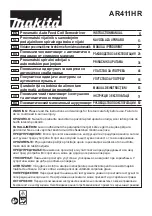
11 ENGLISH
Selecting the operation mode
CAUTION:
Always make sure that the actua-
tion mode selector is properly set to the position
for the desired driving mode before driving a
screw.
This tool is equipped with the actuation mode selector.
You can select either the single sequential actuation
mode or the contact actuation mode with it.
►
Fig.17:
1.
Single sequential actuation mode
2.
Contact actuation mode
Single sequential actuation mode:
You can drive one screw by one sequential operation.
Select this mode when driving a screw carefully and
accurately.
To choose this mode, set the actuation mode selector to
the
position.
Contact actuation mode:
You can drive screws repetitively by placing the contact
element with the trigger held.
To choose this mode, set the actuation mode selector to
the
position.
Checking proper action before
operation
Before operation, always check following points.
— Make sure that the tool does not operate only by
connecting the air hose.
— Make sure that the tool does not operate only by
pulling the trigger.
— Make sure that the tool does not operate only by
placing the contact element against the workpiece
without pulling the trigger.
— In single sequential actuation mode, make sure
that the tool does not operate when pulling the
trigger first and then placing the contact element
against the workpiece.
Single sequential actuation
1.
Lightly press the end of the contact arm onto a
workpiece.
►
Fig.18:
1.
Contact arm
2.
Pull the trigger and hold it until the tool stops run
-
ning. If the trigger is released too soon, the screw may
not be driven in flush to workpiece, and/or the screw
feeding may be impaired.
►
Fig.19
Contact actuation
Pull the trigger first and then place the contact arm
against the workpiece.
Cutting linked sheet
CAUTION:
Always disconnect the air hose
from the tool before removing the linked sheet.
Linked sheet will be ejected from the driver guide as
you drive the screws. Tear away the ejected sheet by
twisting as shown in the figure.
►
Fig.20:
1.
Ejected linked sheet
MAINTENANCE
CAUTION:
Always disconnect the air hose
from the tool before attempting to perform inspec
-
tion or maintenance.
NOTICE:
Never use gasoline, benzine, thinner,
alcohol or the like. Discoloration, deformation or
cracks may result.
Removing jammed screw
1.
Disconnect the air hose from the tool.
2.
Open the door and magazine cap then tear off the
linked screw sheet.
3.
Insert metal bar into the screw ejection hole and
hit it with a hammer lightly.
►
Fig.21:
1.
Metal bar
2.
Hammer
4.
Remove the jammed screw with a flat-blade
screwdriver or other similar tool.
►
Fig.22
Draining water from the tool
Remove the air hose from the tool and place the tool so
that the air fitting faces down to the floor. Leave it for a
while until the water inside the tool is drained.
►
Fig.23:
1.
Air fitting
Storage
When not in use, always disconnect the air hose from
the tool and attach the cap to the air fitting. Clean the
iron dust that adhered to the magnet using an air duster.
The tool should be stored in a warm and dry place.
►
Fig.24:
1.
Cap
Maintenance of compressor and air
hose
Observe the following instructions to keep the optimum
performance and avoid possible tool failure.
•
Always drain the compressor tank after each operation;
•
Keep the air hose away from heat (over 60°C,
over 140°F) ;
•
Keep the air hose away from chemicals such as
thinner, strong acids or alkalis;
•
Route the air hose away from obstacles which
may become dangerously caught on during
operation;












































